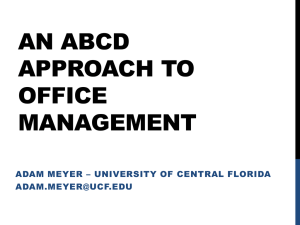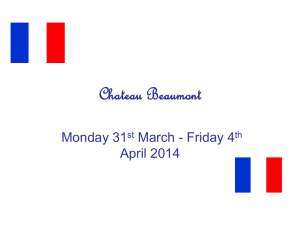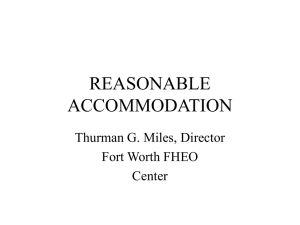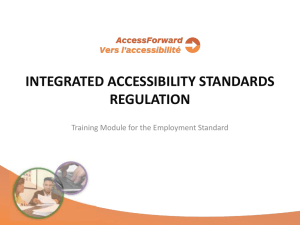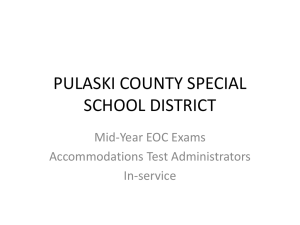Internet marketing
advertisement
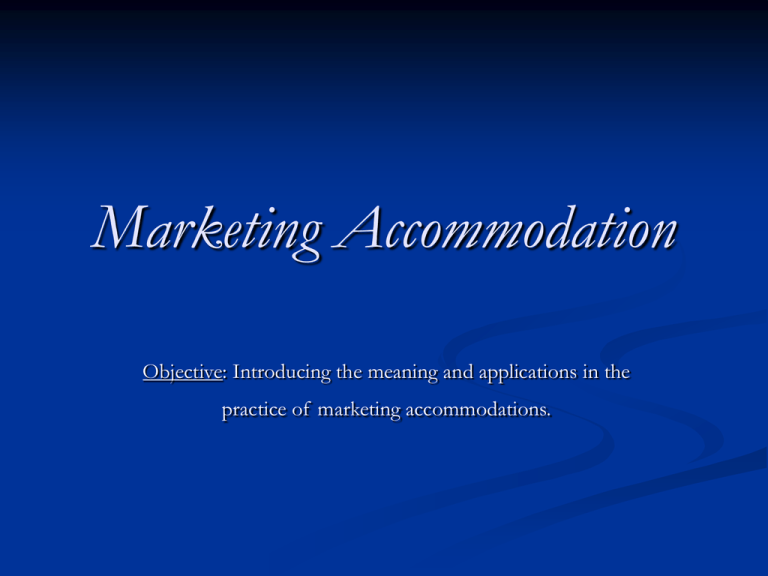
Marketing Accommodation Objective: Introducing the meaning and applications in the practice of marketing accommodations. The nature of the marketing task for accommodation businesses One of the former presidents of Holiday Inn summarizes the marketing task as follows; “All segments of our travel and tourism business have become more competitive. A growing number of competitors offer their products to the same customer groups. Travelers have a wider range of choices than ever before for matching a hotel to their particular travel needs. Those needs change according to the travel purpose. If a company can understand those changing needs and deliver a quality product and services appropriately targeted to specific customers needs, wants, and expectations, that business can survive”. Strategic Marketing Tasks There are six main elements in the strategic marketing response that accommodation suppliers make to their external business environment and the operational characteristics. These are: Evaluating strategic opportunities for growth. Planning the most profitable business mix of segments and products/price ranges, that aim profit rather than volume. Deciding the position, brand or image each accommodation unit (or chain of units) should occupy. Internet marketing Encouraging and rewarding frequent users (relationship marketing). Developing marketing integration between units in common ownership (chains) or units in individual ownership. Evaluating strategic opportunities for growth Strategic growth through globalization, developments in information and communications technologies, through mergers, alliances and acquisitions are among opportunities that should be evaluated. Planning the business mix Because of the demand potential of each location, one of the basic strategic decisions for accommodation businesses is to determine the most profitable target market for their product. For example, a city center hotel will target clients traveling for business purposes. On the other hand, a resort will target leisure visitors and so on. The optimum (most profitable) customer mix for most businesses will usually include several segments (e.g. a resort hotel may have both business and leisure travelers in their target market) in order to maximize revenue and minimize the effects of seasonality and other normal business fluctuations. Designing the optimum mix for any accommodation business requires marketing research or at least an analysis of guestregistration records to analyze the volume and revenue potential of current and prospective (future) customers in each location. Deciding the position or image After determining the target market, the accommodation suppliers should decide about the image that the product is going to create in the minds of the customers. In today’s competitive environment, it is necessary for operators to differentiate and brand their products. Branding is important in order to create and increase the repeat business which is valuable for the profitability of the operation. For example, statistics indicate that people who stay at least 21 nights a year in hotels are estimated to contribute two-thirds of all nights stayed in British hotels. Internet marketing Recent trends including Web 2.0, paid search marketing, eCRM (online customer relationship marketing, web analytics and ROI tracking will impact future hotel marketing. Today electronic tools and management information systems are important tools for marketing managers to collect information on who their customers are. This is important to retain them. Consumer Generated Media (CGM) such as blogs, discussion boards, review and social networking sites can help to retain customers. Therefore, dealing with CGM is becoming a necessity. In addition, most accommodation businesses is shifting to direct marketing on-line. Internet has become the most preferred channel to plan and book accommodation. It is also the cheapest form of distribution. Encouraging and rewarding frequent customers The third element in strategic marketing responses for accommodation suppliers is to find ways to encourage and reward regular customers. Like airline companies, most hotel groups created membership clubs since 1980s in order to attract their regular customers. Some of these programs offer credit facilities in addition to the normal range of benefits, such as rapid check in and check out. Some also offer awards through which frequent travelers can earn points for each stay, leading to attractive prizes according to the number of points collected over a given period. In most cases, the frequent customer programs require building up of name and address lists into databases suitable for direct mail. With the help of direct mail, it is not only possible to reach the regular customers, but also possible to reach the friends and relatives of those customers. However, not all the programs currently in use are fully successful, because they are difficult and expensive to administer. In addition, they may also serve unintentionally to reduce the average room rate to some customers who were prepared to pay a higher price. Integrating marketing across several units The fourth strategic consideration focuses on coordination between the individual units in marketing the products. The strategic advantages of marketing coordination can be summarized as: Distribution referrals of business between units central reservation service better access to distribution networks Promotion corporate branding joint advertising opportunities, use of promotional marketing teams, access to group brochures and leaflets, group representation at trade fairs and shows Product and harmonization in group quality Price guarantee programs designed to build up customer satisfaction Coordination is most easily obtained with the help of ownership. That is why, large accommodation chains have come out over the last 20 years. Large chains are now found in all over the world, and many of them are international in their scope. Tactical Marketing Strategic decisions are expected to generate a profitable mix of bookings and room occupancy as the result of the production and distribution of appropriately priced, distinctive products which satisfy the needs of identified customer segments. In other words, for accommodation operators, three of the four Ps of marketing mix are strategic decisions, and even the fourth, promotion. The main contribution of tactical marketing is to secure additional sales from targeted buyers at times when room occupancy is less than the optimum level. Its other contribution is to cope with sudden losses of business which often happen as a result of unpredictable economic or political events. In certain destinations at certain times, room occupancies in hotels may exceed 80 percent on an annual basis. This results in a rise in prices and profitability. Such circumstances are exceptional and usually are not achieved by marketing alone but by a combination of favorable circumstances in the external environment. It is more common for accommodation businesses to operate somewhere between 55 and 65 percent of room occupancy. Because of the high perishable nature of services, marketing managers are required to manage demand by encouraging additional bookings on a daily and weekly basis. In addition, the high fixed costs and low variable costs of operating accommodation gives importance in providing short term incentives to buyers. That is why, tactical marketing for accommodation businesses require choosing from the range of sales promotion tools. Specifically, sales promotion tactics for accommodation businesses include: Short-term price discounting which is used especially to sell unsold capacity in anticipated situations Sales promotions which add temporary value to products in order to attract targeted customer segments, basically used to increase business in low season. Commission incentives which is designed to motivate a retail distribution system and achieve added influence at points of sale, including improved display for brochures. Deep price discounts designed to motivate and conclude deals with e.g. tour operators or other agents making bulk contracts for accommodation. (This form of selling may also be strategic) Use of sales force to generate additional sales. Tactical use of advertising in order to achieve better communication of promotional offers. The use of these tactical techniques is sales orientated, but their efficient use depends on the detailed knowledge marketing managers have about their target markets. The accommodation sector is often subject to unpredictable external factors. That is why, it is always necessary for operators to allocate contingency funds to be held in reserve for use in influencing short-run demand. Sources Kotler, P.; Bowen, J. and Makens, J. (1999). Marketing for Hospitality and Tourism (2nd ed.). Prentice Hall: NJ. Kotler, P. and Armstrong, G. (2006) Principles of Marketing (11th ed.). Prentice Hall: NJ. Middleton, V. T. C. (2004) Marketing in Travel and Tourism (3rd ed). Elsevier: Oxford. Middleton, V. T. C.; Fyall, A.; Morgan, M. And Ranchhod A. (2009). Marketing in Travel and Tourism (4th ed). Butterworth-Heinemann: Oxford.





